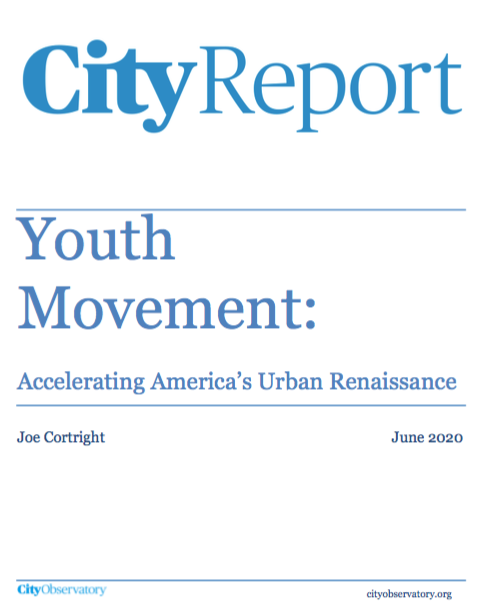What City Observatory did this week
1. Youth Movement: Our latest CityReport. America’s urban revival is being powered by the widespread and accelerating movement of well-educated young adults to the densest, most central neighborhoods in large metro areas. Our new report looks at the latest census data and finds that the number of college-educated 25- to 34-year-olds increased in neighborhoods within three miles of the center of the central business district in every one of the nation’s 52 largest metro areas. Not only that, but in four-fifths of these cities, the rate of increase of this key demographic accelerated after 2010, compared to the prior decade. Despite concerns that the pandemic may be dimming urban prospects, real-time data on real estate searches from Zillow and ApartmentList.com confirm that cities are expanding their market share as suburban shares fall. Our full report has detailed data for each of the nation’s metro areas with 1 million or more population.
2. Covid-19’s Lessons for Portland—and other cities. We’ve witnessed rapid and traumatic change in the past few months, from the Coronavirus pandemic to an outpouring of outrage over police violence. In a guest commentary, our friend Ethan Seltzer begins listing the lessons that these twin crises pose for our urban future. While his comments are aimed at Portland, we suspect the issue he is touching on will be of interest to urban leaders throughout the nation.
3. CityBeat: Pushing back on the Wall Street Journal. There have been a surge of stories predicting that pandemic fears will provoke an urban exodus. This week, the Wall Street Journal weighed in with its entry, asking whether once worker’s could work anywhere whether they’d choose to say in big cities. Like so many such stories, the argument pivots on anecdotes of a New York couple moving to a smaller town in a different state. It’s a fair point that mid-career workers with demonstrated expertise might have that option, but it still turns out, especially for young workers, that there’s no place like a city to find your way to a career, develop your skills and build a personal and professional network. And work isn’t the only reason people choose cities: living in a dense urban environment provides access to more diversity and greater opportunity in the form of social contacts, cultural opportunities and personal interaction.
Must read
1. Tear gas takes aim at dissent: A new video “Choking Dissent: The Truth About Tear Gas” sponsored by Amnesty International and produced by Brooklyn design firm SITU documents the global use of tear gas as an instrument of repression. The video illustrates the chemical and ballistic properties of these munitions, and shows that far from being non-lethal or less-lethal, the projectiles are routinely used to inflict pain and injure protestors; and the gas has a range of adverse health effects, and can even cause death. The documentary combines cell-phone taken at protests–like this one in Philadelphia–with a computer generated image of the surrounding landscape, to illustrate how police deployed gas to trap protestors in a particularly vulnerable location.
2. A Bigger City is a Better City. Alon Levy, transit-expert extraordinaire at Pedestrian Observations has a new essay that unapologetically endorses urban growth and development. Too often, Levy argues, urbanists advance density and development in cities as a necessary evil. That misses the critical point that cities make us better off, making us smarter and more productive, and providing us with opportunities to acquire skills, build networks and enjoy a better life. Levy writes:
Urban development is good
The ability to access more stuff easily is a good thing and there’s a reason both employers and residents pay extra to have it. More and bigger buildings stimulate this kind of access. On the production side, this means thicker social networks for people who work in related industries and can come up with new innovations – this is why the tech industry sticks in San Francisco and environs, and not the bay view or the state of California’s public services. This, in turn, raises wages. On the consumption side, this means more variety in what to buy. Moreover, this is true down to the neighborhood level. A denser neighborhood has more amenities, because more people is a good thing, because new people stimulate new social events, new consumption, and new opportunities for job access.
It’s a clarion call to champion cities, not shrink from them.
3. Corona Virus won’t kill cities. Centre for London’s Ben Rogers weighs in with a warning, but also a call for optimism. The warning is that our initial response to the virus has triggered some anti-urban thinking:
With governments forbidding people from mixing, mayors warning us to avoid public transport and commuters learning they can work from home, you can see why urbanists, city leaders and businesses are worried. It seems all too possible that those who live and work in these cities will vote with their feet – or more likely, their cars. There will be powerful anti-city forces – out-of-town developers, car makers, road builders, oil companies and the champions of conservative, small town, small state values – cheering them on.
But ultimately, Rogers argues, this is exactly the kind of problem that cities have faced in decades and centuries past, and can, given good management, tackle again. Indeed, Rogers thinks that the resilience of cities in the face of this kind of challenge will further accelerate their growth:
The demographic and economic makeup of these cities might change, but people and business will still be jostling for space near the centre. Cities have always worked particularly well for young people. They flock to them to build up vital social and professional networks, meet their mates and learn how the world works. They are also the ones who will find it easiest to adapt to new ways of moving around and contribute most to online innovation.
New Knowledge
Integration and political affiliation. Attending integrated schools means that white kids are less likely to register as Republicans as adults. Political attitudes are shaped by our families and and environments. A new study looks at how differences in school integration shape partisan political identification.
The study, “The Long-run effects of school racial diversity on political identity” by Stephen Billings, Eric Chyn and Kareem Haggag, takes advantage of the implementation of a new school integration plan in Charlotte, North Carolina in the early 2000’s. In place of busing, a federal court ordered a re-drawing of school attendance areas, which meant that kids in some neighborhoods who had been attending segregated schools ended up attending integrated schools. The authors tracked individual students and observed their pattern of voter registration as adults. The key finding: white students who attended integrated schools were significantly less likely to register to vote as Republicans than white students who attended segregated schools.
We find that a 10-percentage point increase in the share of minorities in a white student’s assigned school decreased their likelihood of being a registered as a Republican by 12 percent (2 percentage points), and that this impact was not driven by detectable changes in voting registration.
Factors like parental political affiliation also influence a student’s later political affiliation, but attending an integrated school had about one-sixth as much influence on partisan identification as did parental factors.
Stephen B. Billings, Eric Chyn, and Kareem Haggag, The Long-run effects of school racial diversity on political identity, NBER Working Paper 27302
In the News
CityLab’s Marie Patino reported on the findings of our new report, Youth Movement: Accelerating America’s Urban Renaissance.



